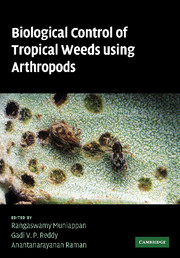Book contents
- Frontmatter
- Contents
- List of contributors
- Acknowledgments
- 1 Biological control of weeds in the tropics and sustainability
- 2 Acacia nilotica ssp. indica (L.) Willd. ex Del. (Mimosaceae)
- 3 Australian Acacia species (Mimosaceae) in South Africa
- 4 Ageratina adenophora (Sprengel) King and Robinson (Asteraceae)
- 5 Azolla filiculoides Lamarck (Azollaceae)
- 6 Cabomba caroliniana Gray (Cabombaceae)
- 7 Invasive cactus species (Cactaceae)
- 8 Chromolaena odorata (L.) King and Robinson (Asteraceae)
- 9 Clidemia hirta (L.) D. Don (Melastomataceae)
- 10 Coccinia grandis (L.) Voigt (Cucurbitaceae)
- 11 Eichhornia crassipes (Mart.) Solms–Laub. (Pontederiaceae)
- 12 Lantana camara Linn. (Verbenaceae)
- 13 Mimosa diplotricha C. Wright ex Sauvalle (Mimosaceae)
- 14 Mimosa pigra L. (Leguminosae)
- 15 Parthenium hysterophorus L. (Asteraceae)
- 16 Passiflora mollissima (HBK) Bailey (Passifloraceae)
- 17 Pistia stratiotes L. (Araceae)
- 18 Prosopis species (Leguminosae)
- 19 Salvinia molesta D. S. Mitchell (Salviniaceae)
- 20 Solanum mauritianum Scopoli (Solanaceae)
- 21 Application of natural antagonists including arthropods to resist weedy Striga (Oranbanchaceae) in tropical agroecosystems
- 22 Biological control of weeds in India
- 23 The role of International Institute of Tropical Agriculture in biological control of weeds
- 24 The role of Secretariat of the Pacific Community in the biological control of weeds in the Pacific Islands region – past, present, and future activities
- Index
16 - Passiflora mollissima (HBK) Bailey (Passifloraceae)
Published online by Cambridge University Press: 04 August 2010
- Frontmatter
- Contents
- List of contributors
- Acknowledgments
- 1 Biological control of weeds in the tropics and sustainability
- 2 Acacia nilotica ssp. indica (L.) Willd. ex Del. (Mimosaceae)
- 3 Australian Acacia species (Mimosaceae) in South Africa
- 4 Ageratina adenophora (Sprengel) King and Robinson (Asteraceae)
- 5 Azolla filiculoides Lamarck (Azollaceae)
- 6 Cabomba caroliniana Gray (Cabombaceae)
- 7 Invasive cactus species (Cactaceae)
- 8 Chromolaena odorata (L.) King and Robinson (Asteraceae)
- 9 Clidemia hirta (L.) D. Don (Melastomataceae)
- 10 Coccinia grandis (L.) Voigt (Cucurbitaceae)
- 11 Eichhornia crassipes (Mart.) Solms–Laub. (Pontederiaceae)
- 12 Lantana camara Linn. (Verbenaceae)
- 13 Mimosa diplotricha C. Wright ex Sauvalle (Mimosaceae)
- 14 Mimosa pigra L. (Leguminosae)
- 15 Parthenium hysterophorus L. (Asteraceae)
- 16 Passiflora mollissima (HBK) Bailey (Passifloraceae)
- 17 Pistia stratiotes L. (Araceae)
- 18 Prosopis species (Leguminosae)
- 19 Salvinia molesta D. S. Mitchell (Salviniaceae)
- 20 Solanum mauritianum Scopoli (Solanaceae)
- 21 Application of natural antagonists including arthropods to resist weedy Striga (Oranbanchaceae) in tropical agroecosystems
- 22 Biological control of weeds in India
- 23 The role of International Institute of Tropical Agriculture in biological control of weeds
- 24 The role of Secretariat of the Pacific Community in the biological control of weeds in the Pacific Islands region – past, present, and future activities
- Index
Summary
Introduction
Originally from the Andes Mountains of South America, the woody vine Passiflora mollissima (HBK) Bailey (Passifloraceae) (banana passion fruit) has been widely disseminated through the world as an ornamental for its large, showy trumpet-shaped flower and large elongate yellow fruit (Fig. 16.1) (Vanderplank, 1991). It is referred to as curubra or tumbo in South America, and as banana poka in Hawaii; poka being a Hawaiian word for twine or twisting. Disseminated by fruit-feeding birds, it has become feral in many semitropical areas of the world, including the island of Madeira in the North Atlantic, in southern Africa (MacDonald, 1987; Henderson, 1995), Kenya (De Wilde, 1976), New Zealand (Young, 1970), and the Hawaiian Islands in the central Pacific.
Introduced as an ornamental vine to the island of Kauai in Hawaii in the 1890s, it was moved to the Island of Hawaii in 1932, and subsequently to the island of Maui. On all three islands it found the mid-elevation (500–2200 m) mountain rain forest (Cuddihy, 1989) an ideal habitat and the introduced birds and feral pigs effective means for dissemination of its seeds. By the mid 1970s, its ability to invade the Hawaiian rain forests and form dense mats of vines that smothered understory plants and broke down mature trees led it to be recognized as a threat to the continued survival of Hawaiian rain forests (Beardsley and Smith, 1978; Waage et al., 1981; Warshauer et al., 1983; LaRosa, 1984).
- Type
- Chapter
- Information
- Biological Control of Tropical Weeds Using Arthropods , pp. 319 - 331Publisher: Cambridge University PressPrint publication year: 2009

